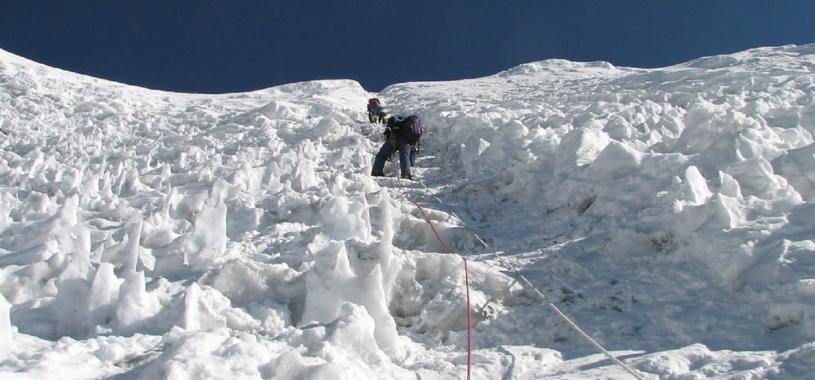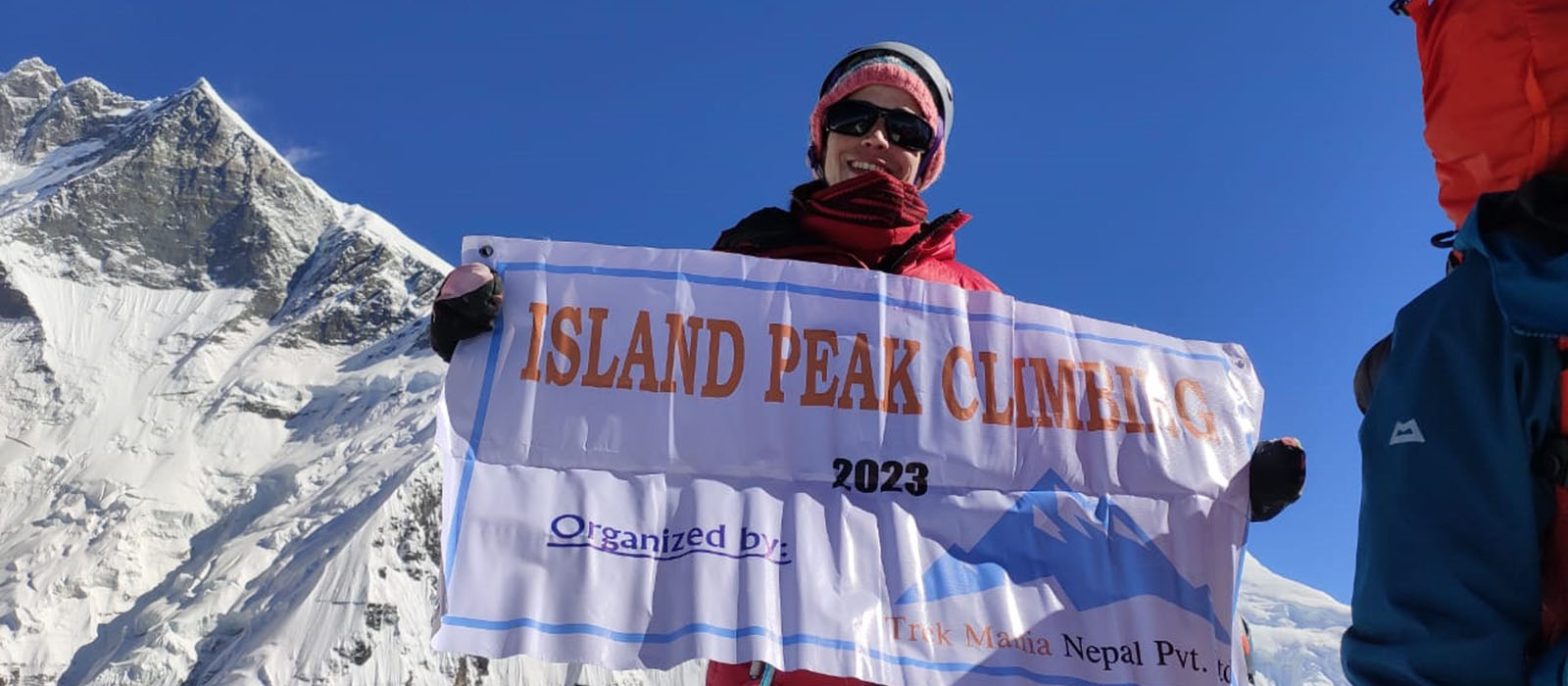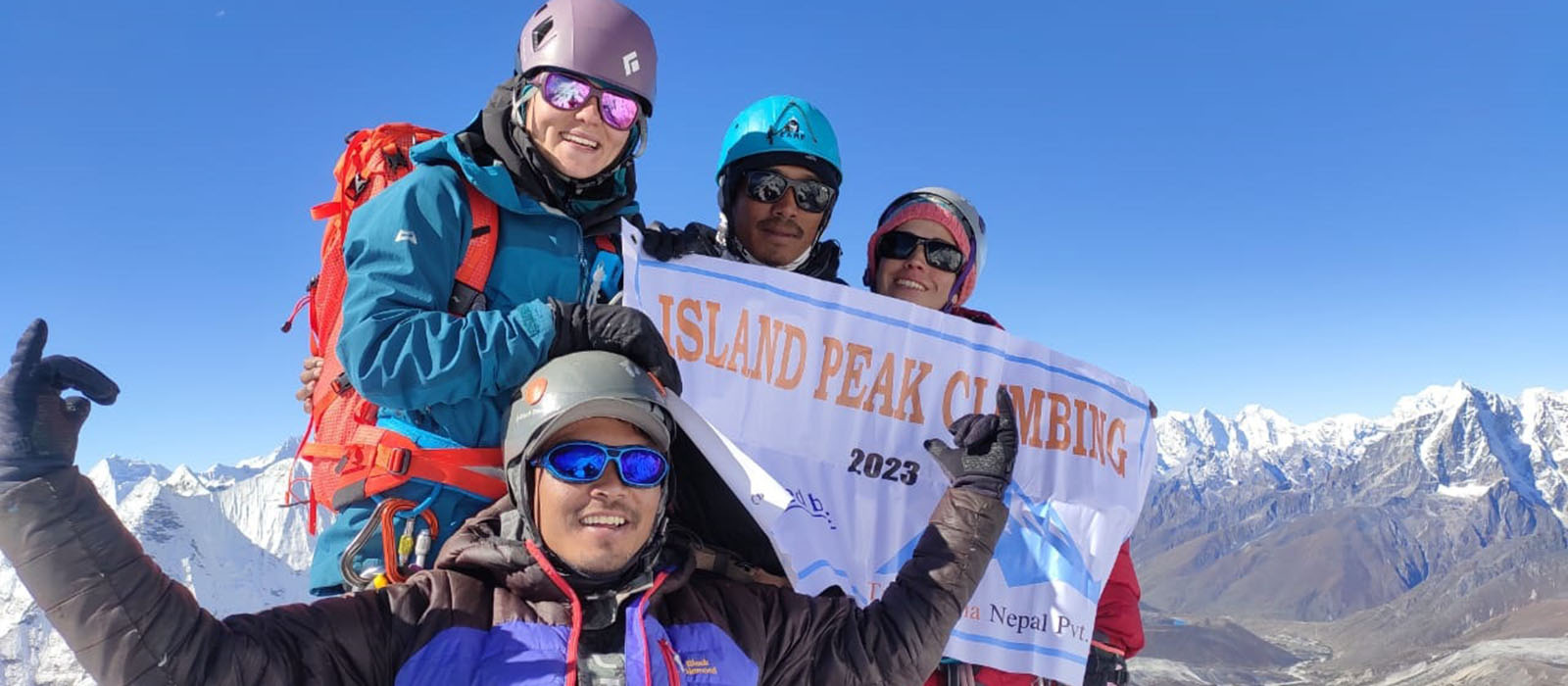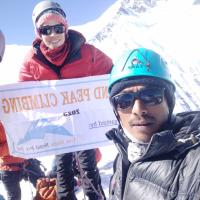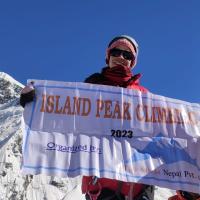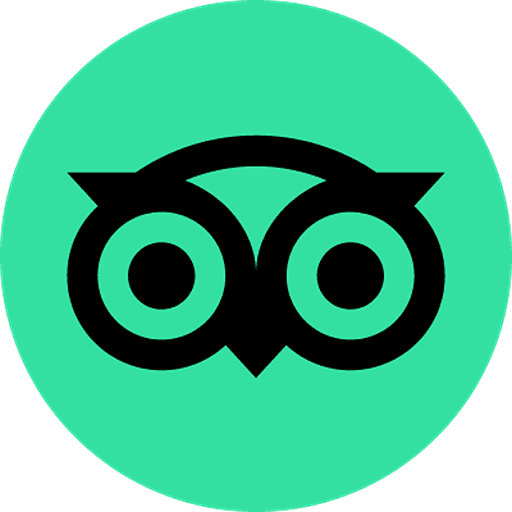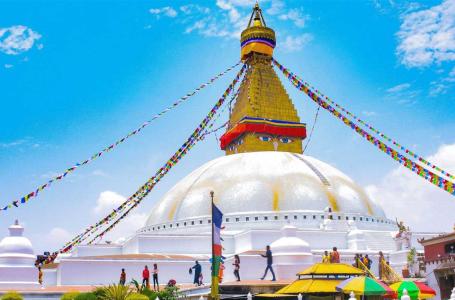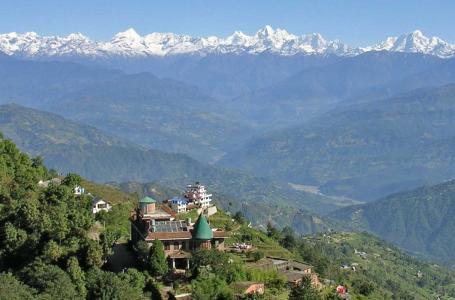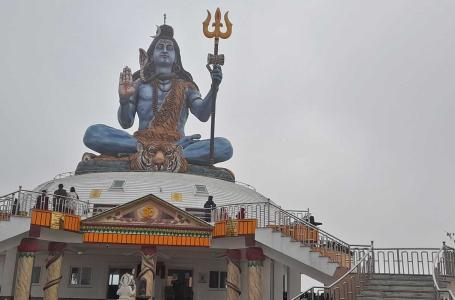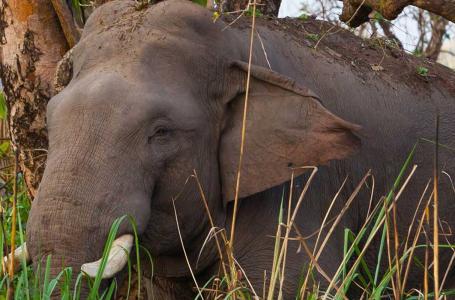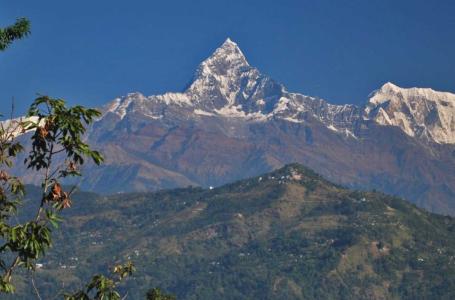- 01 Pax USD 2350 pp
- 02 to 05 Pax USD 2215 pp
- 06 to 10 Pax USD 2145 pp
- 11 to 15 Pax USD 1975 pp
Itinerary
Your journey begins with the excitement of arriving in Kathmandu, Nepal's vibrant capital city. Upon landing, you'll be greeted by the warm Nepali hospitality and transferred to your hotel. Take some time to rest and refresh after your travels, soaking in the bustling atmosphere of Kathmandu and perhaps sampling some authentic Nepali cuisine.
Today is dedicated to preparing for your trekking adventure ahead. Meet with your expedition team for a briefing and gear check, ensuring you have all the necessary equipment for the journey. Spend the day exploring Kathmandu's cultural landmarks, such as Swayambhunath Stupa or Boudhanath Stupa, soaking in the rich history and spirituality of the city.
Embark on an exhilarating flight to Lukla, where the real adventure begins. The flight offers breathtaking views of the Himalayas before landing at one of the world's most famous airstrips. From Lukla, trek to Phakding, following the Dudh Koshi River through picturesque villages and lush forests. Enjoy the gentle rhythm of trekking as you acclimatize to the altitude and soak in the stunning mountain scenery.
Continue your journey towards the legendary Namche Bazaar, a bustling trading hub nestled in the heart of the Himalayas. The trail winds uphill, offering panoramic views of Everest and its surrounding peaks. Cross suspension bridges and pass through quaint Sherpa villages, immersing yourself in the local culture and hospitality. Arrive in Namche Bazaar and spend the evening exploring its vibrant markets and colorful streets.
Today is a rest day to acclimatize to the altitude and prepare for the challenges ahead. Explore the vibrant streets of Namche Bazaar, visit the local monasteries, or hike to nearby viewpoints for stunning views of the surrounding mountains. Take this opportunity to rest and recharge, ensuring you're in peak condition for the rest of the trek.
Resume your trek, ascending through rhododendron forests and alpine meadows towards Tengboche Monastery, one of the most important religious sites in the region. The trail offers breathtaking views of Ama Dablam and Everest, with the sound of chanting monks filling the air as you approach the monastery. Spend the evening exploring Tengboche and soaking in the spiritual ambiance of this sacred site.
Continue your journey towards Dingboche, a picturesque village nestled beneath the towering peaks of the Khumbu region. The trail climbs steadily uphill, offering panoramic views of the surrounding mountains and valleys.
As you ascend, you'll notice the landscape becoming more rugged and barren, with sparse vegetation giving way to rocky terrain. Arrive in Dingboche and enjoy the warm hospitality of the local tea houses, surrounded by the majestic beauty of the Himalayas.
Take a well-deserved rest day in Dingboche to acclimatize to the altitude and prepare for the challenges ahead. Embark on a short hike to Nagarjun Hill or Chhukung Ri for stunning views of Ama Dablam and the surrounding peaks. Alternatively, spend the day relaxing in Dingboche, enjoying the tranquility of this remote mountain village and reflecting on your journey so far.
Continue your ascent towards Lobuche, following the rugged trail through barren landscapes and rocky moraines. The trail offers panoramic views of the Khumbu Glacier and surrounding peaks, with the towering summit of Everest looming in the distance.
As you approach Lobuche, you'll feel the effects of the altitude, with each step requiring greater effort and concentration. Arrive in Lobuche and settle into your tea house for the night, enjoying a warm meal and restful sleep before the challenges of tomorrow.
Today is the culmination of your trek as you journey to Everest Base Camp, the starting point for climbers attempting to summit the world's highest peak. The trail winds through rocky terrain and glacial moraines, offering breathtaking views of the surrounding mountains.
Arrive at Everest Base Camp and bask in the awe-inspiring beauty of this legendary site, surrounded by towering peaks and fluttering prayer flags. After soaking in the scenery, return to Gorak Shep for a well-deserved rest and overnight stay.
Embark on an early morning hike to Kala Patthar, one of the best vantage points for panoramic views of Everest and its neighboring peaks. Watch in awe as the first light of dawn illuminates the Himalayas, casting a golden glow over the snow-capped summits. After capturing unforgettable memories, descend back to Gorak Shep and continue your trek to Lobuche, where you'll spend the night surrounded by the rugged beauty of the Khumbu region.
Leave Lobuche behind as you make your way to Chukkung, a charming village nestled beneath the imposing peaks of Ama Dablam and Lhotse. The trail winds through rocky terrain and alpine meadows, offering stunning views of the surrounding mountains. Arrive in Chukkung and settle into your tea house, enjoying the warm hospitality and breathtaking scenery of this remote mountain outpost.
Begin your journey to Island Peak Base Camp, the starting point for your summit attempt. The trail ascends steadily, passing through rocky terrain and glacial moraines as you approach the base camp. Upon arrival, participate in pre-climb training with your expedition team, learning essential mountaineering skills and techniques for the summit push. Spend the night at base camp, resting and preparing for the challenges ahead.
Today is the day you've been waiting for as you embark on the summit push of Island Peak, one of the most iconic peaks in the Everest region. The climb is challenging and exhilarating, requiring technical skill and endurance to overcome. Ascend steep snow and ice slopes, navigating crevasses and seracs under the guidance of your experienced climbing guides.
Reach the summit and celebrate your achievement, surrounded by panoramic views of the Himalayas stretching to the horizon. After soaking in the breathtaking scenery, begin the descent back to base camp and onwards to Chukkung, where you'll spend the night reliving the memories of your epic climb.
Use this day as a contingency in case of inclement weather or other unforeseen circumstances. The mountains are unpredictable, and it's essential to stay flexible and adaptable to ensure a safe and successful climb. If the weather permits, take the opportunity to explore the surrounding area or simply relax and enjoy the stunning mountain scenery.
Begin your descent back towards Namche Bazaar, retracing your steps through the rugged landscapes of the Khumbu region. The trail winds downhill, offering stunning views of the surrounding mountains and valleys. As you descend, take time to appreciate the natural beauty of the Himalayas and the warm hospitality of the Sherpa people. Arrive in Namche Bazaar and spend the evening exploring the vibrant markets and colorful streets, reminiscing about the unforgettable experiences of your trek.
Continue your journey back to Lukla, where you'll conclude your trekking adventure. The trail winds through picturesque villages and lush forests, offering stunning views of the surrounding mountains. As you approach Lukla, take in the sights and sounds of this bustling mountain town, filled with trekkers and climbers from around the world. Arrive in Lukla and celebrate your accomplishments with your team, enjoying a well-deserved meal and perhaps a hot shower before departing for Kathmandu.
Board a scenic flight from Lukla back to Kathmandu, marking the end of your trekking adventure. The flight offers breathtaking views of the Himalayas, providing a fitting finale to your journey. Arrive in Kathmandu and take some time to relax and unwind, perhaps exploring the city's vibrant markets or visiting one of its many historic sites. Enjoy a farewell dinner with your team, sharing stories and memories of your epic adventure in the mountains.
Bid farewell to Nepal as you board your international flight home, carrying with you memories of adventure, friendship, and triumph in the shadow of the world's highest peaks. Reflect on your journey and the lessons you've learned along the way, knowing that you've accomplished something truly remarkable. Depart with a sense of gratitude for the experiences you've had and the people you've met, knowing that the mountains will always be there, calling you back to explore their beauty once again.
Overview
Island Peak Climbing with Everest Base Camp Trek is a combined journey that helps you to climb the peak along with trekking to the foot of the world’s tallest peak – Mt. Everest (8848.86m). This journey works as an acclimatizing climb before ascending the high mountains such as Ama Dablam, Cho Oyu, Manaslu, and Mt. Everest itself.
Popular as Imja Tse, Island Peak is an astonishing peak among the giants of the Himalayas. Tucked away up the Chukkung valley this beautiful mountain looks like an island that is dwarfed on both sides by the stupendous Lhotse/Nuptse South Wall to the north and Baruntse to the south. The mountains are truly astonishing from the top, and all the more memorable for a spectacular airy ridge climb to the top.
Climbers who dreamed of climbing technical 6000m peaks can do this journey. Climbing this peak will be a training used by Edmund Hillary and Sherpa Tenzing in 1953 and the route they discovered is the same one that is used today. After climbing this peak, climbers will learn about crossing crevasses with ladders, using jumars on a fixed line, and many more.
Our adventure to Island Peak with the EBC trek begins with a short 40-minute mountain flight to Lukla from Kathmandu. After Landing at Tenzing Hillary Airport Lukla, we begin our trek towards Phakding and spend the overnight there.
The next day, we ascended to Namche Bazaar and spent a more day there for acclimatizing practices. Spending about five more days from here, we reach Everest Base Camp. Celebrating the moments in Everest Base Camp, we hike back to Gorekshep and begin another adventure; Island Peak Climbing.
Within a couple of days, we reach the top of Island Peak and we get to trek back to Lukla and fly back to Kathmandu before completing the entire adventure.
Planning Island Peak Climbing with Everest Base Camp:
Island Peak is a popular hiking summit in Nepal that demands careful planning to climb successfully. Start by thoroughly researching the criteria and restrictions, study acclimatization, and verify necessary permissions, including those from Sagarmatha National Park and the Nepal Mountaineering Association. Choose a trustworthy trekking company to help with logistics, permits, and skilled guides. It is also required since solo travel in Nepal is prohibited and necessary for your own safety.
Next physical training is essential, emphasizing cardiovascular fitness, strength, and other exercises. Acclimatization is required and can be done while hiking in the Everest region. It helps your body gradually adapt to higher altitudes, lowering the risk of altitude-related illnesses, improving safety, improving physical performance, providing a rich cultural and natural experience, allowing for a gradual ascent, and providing breathtaking scenic beauty along the way. Make a detailed gear list that includes mountaineering necessities such as boots, crampons, an ice axe, a harness, and warm clothes. Prioritize your safety and health and have the required medications on hand.
Don't forget to follow the Leave No Trace guidelines to respect the environment and local culture, and get full travel and medical insurance. Island Peak is a difficult undertaking, and appropriate planning and safety precautions are essential for a successful ascent.
If you are looking for Base Camp Service - we also offer Short Island Peak Climbing from Chhukung.
The best time to do the Island Peak Climbing with Everest Base Camp Trek?
There are mainly two seasons that are recommended for Island Peak Climbing with Everest Base Camp Trek Spring and Autumn. Both of these seasons provide favorable weather, consistent temperatures, and great views of the surrounding mountains, all of which are essential for a safe and pleasurable climb up Island Peak.
Spring(Late April to early June) is considered the best time as the weather is typically steady during this season, with clear skies, less precipitation, and warmer temperatures. The pathways are very lush and full of rhododendrons and other flowers. The months of late September to early November(Autumn) are also ideal for ascending Island Peak. The monsoon season has ended, leaving the landscapes lush and green and the skies clear. The temperatures are also more conducive to climbing, making it a popular destination for hikers and climbers.
Due to excessive rainfall, gloomy skies, and increased dangers of avalanches and landslides during the monsoon season (June to early September), ascending Island Peak is not advised. The paths become wet and hazardous, making climbing dangerous and impracticable. Similarly, climbing Island Peak during the winter months (December to February) is not recommended owing to extremely low temperatures, sub-zero conditions at higher elevations, and obstructed paths due to snow and ice. The difficulty and hazard of the climb might be considerably increased by harsh winter conditions.
Foods and Accommodations:
When you go on your Island Peak climbing trip in Nepal's Everest area, you can anticipate a variety of dining and hotel alternatives to suit your requirements and interests.
Tea houses are the most popular option, providing nice rest stops along the way. These accommodations provide modest yet pleasant amenities such as mattresses, blankets, and communal restrooms. Camping gives you more solitude and independence, but it requires you to bring your own camping gear and groceries. Staying at base camps, such as those in Chukung or Dingboche, is a wonderful alternative because they are designed to accommodate climbers and trekkers. A base camp with modest lodges is located closer to Island Peak and serves as a handy starting point for your trek.
Along the trekking path, tea houses and lodges provide a broad menu of both local and international foods. This contains classic Nepali dishes such as dal bhat as well as a choice of meat and vegetarian options. As you rise to higher elevations, the menu frequently changes to include more readily digestible dishes like soups, stews, and carbohydrate-rich options.
It is always advised to consult with your guide for a better and hygienic selection of food.
Transportation:
Because there is no direct flight from Kathmandu to Lukla, visitors must drive for four hours (by shared Hiace Van) from Kathmandu to Manthali Airport. This is because of high traffic at Kathmandu's international airport (October-November and March-April). Then we'll fly directly from Rameechap Manthali Airport to Lukla Airport). If you wish to go by private vehicle, you must pay an extra fee of USD 100. In terms of flight time, passengers should check out about 1 a.m. for a same-day departure. If you want to stay one night in Rameechap for the same-day flight, you will be charged a hotel fee of around USD 20 per person.
Note: If you are flying during the off-season (January-February or May-September), you may take a direct flight to Lukla from Kathmandu's Tribhuvan International Airport.
Our tour will conclude in Lukla, where we will fly back to Rameechap Manthali Airport and take a shared Hiace vehicle to Kathmandu the following day.
(Again, private vehicles are an additional fee and are not included in this package.)
Necessary Permits & TIMS:
To visit the territory, Island Peak requires three sorts of permits. A Trekker's Information Management System (TIMS) Card is no longer required. These permissions can only be obtained from licensed agencies, and no freelancing guide can give them.
Khumbu Pasang Lhamu Rural Municipality Entrance Permit:
This permit is intended to supervise and handle tourism activity in the Khumbu region. It is necessary across the Khumbu region, including Namche Bazaar, Tengboche, Dingboche, and Gorakshep, and is valid till Jiri.
Cost: NPR 2000 Per Person for each foreigner.
Sagarmatha National Park Entry Permit:
The purpose of this permit is to restrict and manage entry to the Sagarmatha National Park to preserve its natural beauty and biodiversity. The cash collected by these permits is utilized to conserve and maintain the park.
Cost: NPR 3000 Per Person for each Foreigner
Island Peak Climbing permit:
A climbing permit is a legal authorization or license issued by a relevant body or organization to individuals or groups that authorizes them to climb a certain mountain, or designated climbing area. These climbing permits differ according to the region and the governmental agency in charge of the area.
Cost: Island Peak Climbing permits cost for the months of March, April, and May, costs USD $250, as these months offer ideal conditions with clear and mild weather. In contrast, during September, October, and November, the permit fee is USD $125 for the autumn season, which is a popular time for Mera Peak Climbing. The permit price is lower during the winter and summer months, which are considered off-seasons. Moreover, for December, January, and February, the permit fee is USD $70.
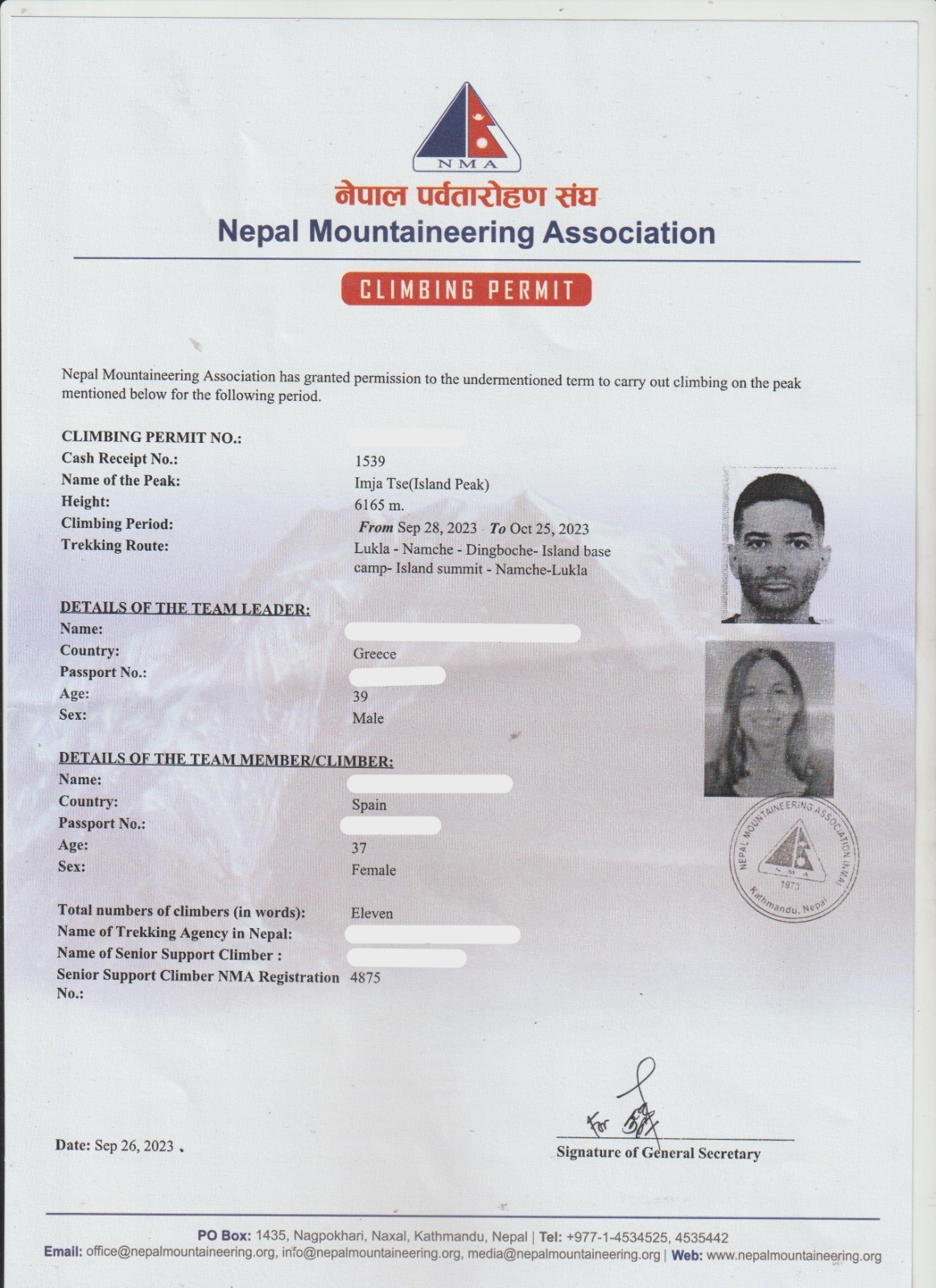
(All the permits required are included in this package).
Necessary documents for Permits:
- You will only need your valid passport photocopy(validity of 6 months).
- Passport-size photos 2p.
- Travel insurance papers (includes helicopter evacuation of up to 6000m)
Highlights
- Climb Island peak 6,189 m, is one of the most popular trekking peaks in Nepal.
- Visit the cultural, historical, and cultural wonders of Nepal.
- It is the best combination of Himalayan trekking and climbing.
- An easy ascent up a 6,000-meter peak for first-time climbers.
- Experience Sherpa culture and Himalayan views of 7,000 and 8,000-meter peaks
Cost Details
- Two night Deluxe Hotel in Kathmandu.
- Flight: Kathmandu – Lukla - Kathmandu
- Island Peak Climbing Permit.
- Included Garbage disposal charge.
- Sagarmatha National Park Entry Permit.
- Khumbu Pasang Lhamu Rural Municipality Entry Permit.
- One climbing guide (Sherpa) among two members.
- All Ground transport as per the itinerary.
- All standard Meals (Breakfast, Lunch and Dinner) throughout the trek and climb
- Breakfast in Kathmandu
- Accommodation in lodge during the trek and basic camping arrangement during climbing.
- A porter for every two passengers (please make your bag 15 kg and around)
- Insurance for every staff
- Island Peak Climbing Map
- Emergency Helicopter rescue arrangement if in case (pay by your travel insurance) in the worst case only)
- Sleeping, bag down jackets if you do not have your own, to be returned after the trip.
- First Aid Box carried by the porter
- Seasonal Fruits throughout the trek
- Medical supplies, first aid kit box, including Oximeter and pulse meter checker.
- All other government taxes and expenses
- Personal clothing, gear and climbing equipment
- Personal accident insurance, emergency evacuation cost, oxygen, medical box.
- Alcoholic beverage, laundry and tips.
- Extra night Hotel accommodation and sightseeing tour in Kathmandu (available as per your choice)
Equipment List
Checklist for Island Peak Climbing in Nepal
For Head
- Balaclava that covers your ears
- Headlamp with extra batteries and bulbs
- Bandana or headscarf, very useful for dusty conditions
- Beanie
- Wide-brimmed sunhat
- Neck gaiter or warmer
- Snow goggles and Sunglasses with UV protection
(Carry an extra pair in case you lose or break it) - Prescription sunglasses (if required)
For Upper Body
- T-shirt (moisture absorbing and breathable)
- The thermal base layer of merino wool
- Fleece wind-stopper jacket or pullover
- Waterproof (preferably breathable fabric)
- Long sleeve shirt (moisture absorbing and
- Shell jacket
- Down Vest
- Expedition weight insulated down jacket with hood
(not required for all trekking peaks ) - Gore-Tex jacket with hood, waterproof and breathable
For Hands
- A pair of lightweight poly-liner gloves or lightweight wool or fleece gloves
- Summit Mittens(warm insulated gloves with safety straps)
For Lower Body
- Lightweight thermal leggings of merino wool
- Trekking trousers (waterproof, breathable fabric)
- Hardshell trousers
- Non-cotton underwear briefs
- Hiking shorts
- Synthetic insulated pants
For Feet
- Lightweight inner socks, heavy poly or wool socks, and cotton socks
- Running shoes and rubber sandals/flip-flops
- Double-insulated climbing boots
- Good quality hiking boots (sturdy soles, water-resistant, ankle support, “broken-in”)
- Gaiters
For Sleeping Purpose
- Sleeping Bag ( a 5-season sleeping bag, suitable for temperatures as low as -40°C)
- Foam pad
- Fleece sleeping bag liner
- Therm-a-Rest sleeping pad (NeoAir XTherm) which offers insulation and warmth in sub-freezing temperatures
- Pillowcase
Personal Climbing GearsIce axe
- Crampons
- Ascender/Jhumar
- Prusik rope
- Helmet
- Harness
- Tape slings (2)
- Screwgate karabiners (2 locks, 2 unlock)
- Descender/eight-figure
- Plastic mountaineering boots
Group Climbing Gears
- Snow bar
- Rope
- Ice hammer
- Ice screw
Baggage
- Rucksack and Travel Bags
- A small daypack/backpack(30-40L) for carrying your
- valuables should have good shoulder padding.
- Large duffel bag (80-100L)
- Small padlocks for duffel-kit bags
Medical
- Small, personal first-aid kit (simple and light)
- Paracetamol
- Cough and/or cold medicine
- Anti-altitude sickness pills - Diamox or Acetylzolamide
- Stomach antibiotic - Ciprofloxacin, etc. Do not bring
- sleeping pills as they are a respiratory depressant.
- Skin-blister repair kit
- Anti-diarrhea pills
- Throat lozenges
- Water purification tablets or the water filter
- Earplugs
- lip guard
- Eye drops
- Extra pair of prescription glasses, contact lens supplies
- Sunscreen
Practical Items
- Alarm clock/watch
- Camera with extra SD cards and batteries
- Large Ziploc bags
- 2 water bottles (1 liter each)
- Small roll of repair tape, sewing-repair kit
- Binoculars (optional)
- 4 large, waterproof, disposable rubbish sacks
- adapter Type C (with circular pins)
- Cigarette lighter / small box of matches
- Compass or GPS(optional)
- Lightweight steel thermal bottle
- Small folding or Swiss knife
- Trekking poles(foldable)
Toiletries
- Deodorants
- Nail clippers
- Face and body moisturizer
- Female hygiene products
- Small mirror
- Medium-sized quick-drying towel
- Toothbrush/paste (preferably biodegradable)
- Multipurpose soap (preferably biodegradable)
Personal Hygiene
- Anti-bacterial handwash
- Hand sanitizer
- Pee Bottle (1 liter, leak-proof, wide mouth)
- Pee funnel (for female)
- Wet wipes (baby wipes)
- Tissue /toilet roll
Extras/Luxuries
- Reading book
- Trail map/guidebook·
- Journal and pen
- Playing cards (to help you pass the time at teahouses and/or camps)
- A modest swimsuit
- Binoculars (optional)
FAQs
Trekking to Everest Base Camp first helps with acclimatization, increasing the chances of a successful Island Peak summit. It also offers an iconic trekking experience before the climb.
The steep ice wall (40-50°) before the summit and the final narrow ridge are the toughest sections. Climbers must use fixed ropes, ascenders, and crampons for the ascent.
Some basic gear is available for rent in Chhukung, but for quality and fit, it’s better to rent or buy in Kathmandu before the trek.
Gradual acclimatization, hydration, a steady pace, and proper nutrition are key. Diamox (if advised by a doctor) can also help reduce symptoms.
If you can’t summit due to weather or health issues, your guide will assess the situation. Some itineraries allow an extra summit attempt if time permits.
Travellers Review
Everest Base Camp and Island Peak
During my first trek in Nepal (April 2023) I met Bhim, one of the best guides you can find, he is very kind and I loved hearing from him all the stories about Nepalese culture. When I came back to Nepal I contacted him and decided to do the Everest Base Camp trek + Island Peak with the agency “Trek Mania Nepal”, it was a great experience, they are attentive to all your needs and very well organised, if there is any incident on the way, for example due to the weather or flight cancellation from Luckla (as it was in my case) they keep you update and inform you about all the possible solutions. This time Bhim was busy and Hem, one of the company’s guide came with me, an other excellent guide, I really enjoyed sharing this trek with him, he was really helpful during the whole trek. I got ill a few days due to high altitude sickness and he was very caring and helpful, I will always be grateful to him. In summary I highly recommend this company and their guides, it is full of good people.


